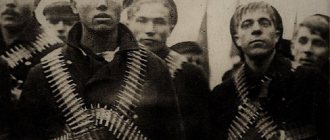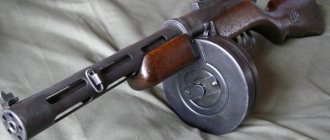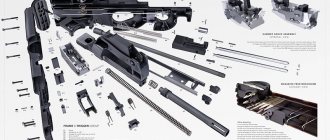Light machine gun PKP Pecheneg (Russia)
PKP Pecheneg light machine gun (serial version).
PKP Pecheneg light machine gun, view of the receiver, barrel casing with air supply windows and carrying handle.
PKP Pecheneg light machine gun, view of the muzzle of the weapon with a bipod and a special flash suppressor.
Caliber:
7.62x54mm R
Weight without cartridges:
8.2 kg on bipod;
12.7 kg on a tripod machine Length:
1155 mm
Barrel length:
658 mm
Power:
100 or 200 rounds of
ammunition Rate of fire
: 650 rounds per minute
The Pecheneg light machine gun was developed at the Central Research Institute of Precision Engineering (Russia) as a further development of the standard army PKM machine gun. Currently, the Pecheneg machine gun has passed army tests and is in service with a number of army and Ministry of Internal Affairs units participating in the anti-terrorist operation in Chechnya. In general, reviews of the new machine gun from the troops are positive. Due to the lack of a replaceable barrel, the machine gun became more mobile and, therefore, more suitable for modern combat operations.
The main task when creating the Pecheneg was to increase the efficiency of fire and get rid of such a drawback of most modern single machine guns as the need for a replaceable barrel. The result of the work of TsNIITochMash was the creation of a barrel with forced ejection air cooling of the barrel. The Pecheneg barrel has specially designed external fins and is enclosed in a metal casing. When firing, powder gases coming out of the barrel at high speed create the effect of an ejection pump in the front part of the casing, drawing cold air along the barrel. Air is taken from the atmosphere through windows in the casing, made under the carrying handle, in the rear part of the casing. Thus, it was possible to achieve a high practical rate of fire without the need to replace the barrel - the maximum length of a continuous burst from a Pecheneg is about 600 shots - that is, 3 boxes with belts of 200 rounds of ammunition, or a standard portable ammunition load. When conducting a long battle, the machine gun can fire up to 1000 rounds per hour without deteriorating combat characteristics and reducing the barrel life, which is at least 30,000 rounds. In addition, due to the enclosure of the barrel in the casing, thermal moire (oscillations of hot air over a heated barrel during intense fire), which interfered with accurate aiming, disappeared. Another modification in relation to the PKM was the relocation of the bipod under the muzzle of the barrel. This was done to increase the stability of the machine gun when firing from a bipod, however, this position of the bipod is not always convenient, as it limits the sector of fire along the front without moving the shooter and/or weapon.
In general, the Pecheneg retained up to 80% of the common parts with the PKM (receiver with all mechanisms, machine), and the increase in fire efficiency ranged from 150% when firing from a machine to 250% when firing from a bipod (according to the developers).
Modifications of Pecheneg
The Pecheneg, modernized for various battle conditions, is produced in the following versions:
- 6P41S – machine gun used on a machine designed by Stepanov;
- 6P41N – infantry machine gun with a night sight;
- 6P41SN – easel night machine gun.
A shortened version of the “Pecheneg” was also developed according to the “bullpup” design. It was made for special forces.
The new shortened assault machine gun differs from the ordinary “Pecheneg” in the absence of a stock. Instead, they installed an L-shaped small buttstock with a forward handle and a soft butt plate. Due to this modernization, the shortened machine gun became lighter by 0.5 kg and shorter by 27 cm. The barrel length did not change - 65 cm.
The design of the machine gun itself is quite fascinating; most likely, the shortened machine gun will find its niche in special forces. A similar machine gun is perfect for suppressing firing points or barrage fire at close range.
Advantages of modernization:
- compactness;
- reduced weight;
- improved muzzle brake-compensator;
- the ability to install additional special tactical modules;
- duplicated trigger mechanism.
But the shortened machine gun, along with its advantages, also received a number of natural disadvantages. Nevertheless, the Russian military-industrial complex expects to include a new shortened machine gun in one of the future versions of the promising “Warrior” equipment.
Options for different departments
Modifications of the new PKP Pecheneg have been assigned the following GRAU indices:
- 6P41N – Picatinny rail for night sights;
- 6P41S – equipped with a 6T5 Stepanova machine;
- 6P41SN – machine plus night sight;
- Bull Pup - assault machine gun, the trigger is located in front of the belt;
- 6P69 – adjustable stock, folding, tactical silencer, forced cooling of the barrel without casing, Picatinny rail.
By default, the assault Bullpup is equipped with the latest dovetail strap, lighter than the PKP by 0.5 kg, and the barrel of the weapon is 27 cm shorter. The trigger mechanism is duplicated, the flash suppressor is replaced by a muzzle compensator.
However, the assault Pecheneg cannot be mounted on the machine, the weight distribution of the weapon is disturbed, and if there are body kits, it is difficult to adjust the gas regulator. Modifications of the PKP are used by the armed forces and special forces of Namibia, Yemen, Syria, the Russian Federation, Kyrgyzstan and Kazakhstan.
Advantages of a machine gun
Design features that distinguish Pecheneg —
machine gun of the latest development - such that they can easily re-equip the entire army for this weapon. Firstly, the machine gun uses almost a complete set (80%) of parts and assemblies from PKM. Secondly, its design almost completely copies the same machine gun. This will not only facilitate its operation, since most soldiers are already trained in the techniques of shooting with PKM, but will also significantly simplify production, which will play into the hands in the case of limited finances.
"Pecheneg" is a machine gun, mass produced for the growing needs of the army. Naturally, multitasking required the creators to make additional adjustments and improvements to the design. This is how modifications of this weapon appeared. Today, the “Pecheneg 2” machine gun, sufficiently modernized, will be able to perform a wide range of tasks.
The task of producing these weapons was taken over by the Kovrov plant named after Degtyarev, also known as OJSC ZiD. It is here that the modernized Pecheneg machine gun is currently being produced.
The following models are currently offered:
- 6P41 - single, caliber 7.62 mm;
- 6P41S - the same machine gun, but mounted (a Stepanov machine is used);
- 6P41N - night version of a single machine gun;
- 6P41SN - easel night version.
Operating principle of the control panel
As stated in the technical specifications for the development of “Pecheneg”, the main components and mechanisms remained from the basic PKM model without significant changes.
The automation is driven by the energy of powder gases from the barrel to a gas piston connected to the bolt frame. Turning the bolt locks the barrel. The trigger mechanism is driven by a recoil spring located in the bolt frame. The shot is fired from the rear sear; the design of the trigger mechanism allows exclusively automatic fire. The safety lock secures the trigger lever and sear. On the right is the reload handle, which is motionless when firing. The cartridges are fed by a belt, from right to left.
Accuracy
A successful technical solution of the barrel group also creates another positive effect - the shooter is not disturbed by moiré air vibrations that distort the optical picture.
The barrel became, of course, thicker, but also stronger. This prompted the designers of the Tochmash Central Research Institute to place the bipod mount in front, almost in the plane of the muzzle, which reduced vibrations caused by recoil. Scattering was reduced by 70%. True, changing the angle of the line of fire has now become somewhat more difficult, the shooter has to move a greater distance, but in technology it is always like this: by improving one thing, you worsen another. Accuracy is still more important. It became possible to fire with sniper precision. For shooting at night, an infrared sight is provided; in other cases, a collimator optical sight can be used.
The emergence of the Pecheneg machine gun
As the structure of army units and combat tactics changed, the Kalashnikov machine gun ceased to meet modern requirements. It was necessary to modernize the performance characteristics and weapon design:
- increased barrel life - the Kalashnikov machine gun had two replaceable barrels, installed alternately as they heated to critical temperatures;
- reduction of haze above the barrel - warm air refracts the perspective and interferes with aiming;
- increased burst density - ballistic properties deteriorate sharply as the barrel heats up.
At the same time, it was undesirable to increase the cost of production by much, so the development by a team of gunsmiths - A. S. Neugodov, A. A. Deryagin, M. V. Chugunov, V. I. Suslov and N. N. Denisov - was carried out jointly with the craftsmen of the Kovrov Mechanical Plant .
Since the capacity and equipment of the mechanical plant were not enough for the industrial production of weapons, the Pecheneg machine gun went into production at the plant named after. Degtyarev, where all the necessary conditions were available for this.
History of the development of the PKP (Kalashnikov infantry machine gun) “Pecheneg”
In the 80s, the Kalashnikov machine gun was recognized as one of the best in the world. As a veteran of countless military conflicts of the 20th century, it has become something of a “standard” for efficiency, simplicity and reliability.
But as time passed, the basic requirements also changed. New Western models were hot on their heels and even began to surpass them in some criteria. In addition, Afghanistan, and later Chechnya, showed the need to modernize the existing machine gun.
The designers were given the following tasks:
- increasing shooting efficiency without making fundamental changes to the design of the weapon or its ammunition;
- increasing the accuracy of fire;
- increasing the overall service life of parts and mechanisms, improving performance characteristics.
In the mid-90s, the solution to these problems was entrusted to specialists from the TsNIITOCHMASH JSC near Moscow. After conducting a series of scientific studies and conducting many experiments, it was found that the effectiveness of machine gun fire is largely influenced by the incorrect temperature balance of the barrel. When shooting, uneven heating occurs, which leads to some displacement of the sight.
To eliminate this, the designers changed its contour and made the barrel itself heavier. The so-called “thermal mirage effect” that occurs after prolonged shooting was also eliminated. In the course of this work, a new PKP “Pecheneg” appeared (interpretation: Kalashnikov infantry machine gun (“Pecheneg”), which is a worthy successor to the legendary PKM.
New development of designers - the Pecheneg machine gun
At the end of the 20th century, mass production began at the Kovrov Mechanical Plant. It entered service with the troops as an infantry Kalashnikov machine gun, but for soldiers it is a “Pecheneg” - a terrible and formidable weapon.
Machine gun development
The design team of the TsNIITochmash plant, which was tasked with developing this weapon, had such a difficult task as improving the cooling of the machine gun barrel, which was supposed to increase the accuracy and rate of fire. As practice has shown, the progenitor of the Pecheneg, the PKM, often overheated. Therefore, the designers took a simple route - taking the old PKM as the basis for the new machine gun, they changed its design and also added new elements, such as a splitter handle, an ejector and a barrel casing.











